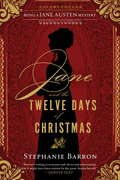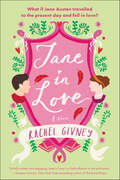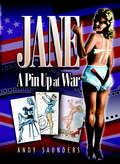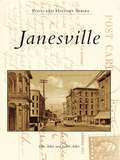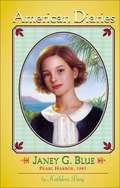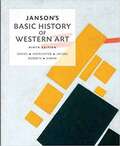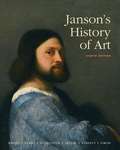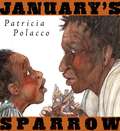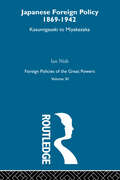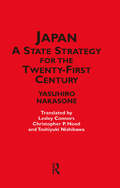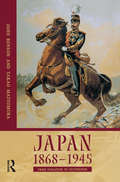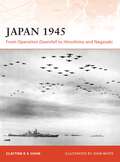- Table View
- List View
Jane and the Madness of Lord Byron: Being A Jane Austen Mystery
by Stephanie BarronThe restorative power of the ocean brings Jane Austen and her beloved brother Henry, to Brighton after Henry’s wife is lost to a long illness. But the crowded, glittering resort is far from peaceful, especially when the lifeless body of a beautiful young society miss is discovered in the bedchamber of none other than George Gordon—otherwise known as Lord Byron. As a poet and a seducer of women, Byron has carved out a shocking reputation for himself—but no one would ever accuse him of being capable of murder. Now it falls to Jane to pursue this puzzling investigation and discover just how “mad, bad, and dangerous to know” Byron truly is. And she must do so without falling victim to the charming versifier’s legendary charisma, lest she, too, become a cautionary example for the ages.From the Trade Paperback edition.
Jane and the Twelve Days of Christmas: Being a Jane Austen Mystery
by Stephanie BarronThe twelfth installment in Stephanie Barron's fan-favorite Being a Jane Austen Mystery seriesChristmas Eve, 1814: Jane Austen has been invited to spend the holiday with family and friends at The Vyne, the gorgeous ancestral home of the wealthy and politically prominent Chute family. As the year fades and friends begin to gather beneath the mistletoe for the twelve days of Christmas festivities, Jane and her circle are in a celebratory mood: Mansfield Park is selling nicely; Napoleon has been banished to Elba; British forces have seized Washington, DC; and on Christmas Eve, John Quincy Adams signs the Treaty of Ghent, which will end a war nobody in England really wanted. Jane, however, discovers holiday cheer is fleeting. One of the Yuletide revelers dies in a tragic accident, which Jane immediately views with suspicion. If the accident was in fact murder, the killer is one of Jane's fellow snow-bound guests. With clues scattered amidst cleverly crafted charades, dark secrets coming to light during parlor games, and old friendships returning to haunt the Christmas parties, whom can Jane trust to help her discover the truth and stop the killer from striking again?
Jane and the Unpleasantness at Scargrave Manor: Being the First Jane Austen Mystery (Being A Jane Austen Mystery #1)
by Stephanie BarronFor everyone who loves Jane Austen . . . a marvelously entertaining new series that turns the incomparable author into an extraordinary sleuth! On a visit to the estate of her friend, the young and beautiful Isobel Payne, Countess of Scargrave, Jane bears witness to a tragedy. Isobel's husband—a gentleman of mature years—is felled by a mysterious and agonizing ailment. The Earl's death seems a cruel blow of fate for the newly married Isobel. Yet the bereaved widow soon finds that it's only the beginning of her misfortune . . . as she receives a sinister missive accusing her and the Earl's nephew of adultery—and murder. Desperately afraid that the letter will expose her to the worst sort of scandal, Isobel begs Jane for help. And Jane finds herself embroiled in a perilous investigation that will soon have her following a trail of clues that leads all the way to Newgate Prison and the House of Lords—a trail that may well place Jane&’s own person in the gravest jeopardy.Praise for Jane and the Unpleasantness at Scargrave Manor&“There&’s plenty to enjoy in this crime-solving side of Jane. . . . [She] is as worthy a detective as Columbo.&”—USA Today&“Happily succeeds on all levels: a robust tale of manners and mayhem that faithfully reproduces the Austen style—and engrosses to the finish.&”—Kirkus Reviews &“Splendid fun!&”—Star Tribune, Minneapolis
Jane and the Waterloo Map
by Stephanie BarronJane Austen turns sleuth in this delightful Regency-era mystery November, 1815. The Battle of Waterloo has come and gone, leaving the British economy in shreds; Henry Austen, high-flying banker, is about to declare bankruptcy--dragging several of his brothers down with him. The crisis destroys Henry's health, and Jane flies to his London bedside, believing him to be dying. While she's there, the chaplain to His Royal Highness the Prince Regent invites Jane to tour Carlton House, the Prince's fabulous London home. The chaplain is a fan of Jane's books, and during the tour he suggests she dedicate her next novel--Emma--to HRH, whom she despises.However, before she can speak to HRH, Jane stumbles upon a body--sprawled on the carpet in the Regent's library. The dying man, Colonel MacFarland, was a cavalry hero and a friend of Wellington's. He utters a single failing phrase: "Waterloo map" . . . and Jane is on the hunt for a treasure of incalculable value and a killer of considerable cunning.From the Hardcover edition.
Jane and the Year Without a Summer (Being a Jane Austen Mystery #14)
by Stephanie Barron"If you have a Jane Austen-would-have-been-my-best-friend complex, look no further . . . [Barron] has painstakingly sifted through the famed author's letters and writings, as well as extensive biographical information, to create a finely detailed portrait of Austen's life—with a dash of fictional murder . . . Some of the most enjoyable, well-written fanfic ever created."—O Magazine May 1816: Jane Austen is feeling unwell, with an uneasy stomach, constant fatigue, rashes, fevers and aches. She attributes her poor condition to the stress of family burdens, which even the drafting of her latest manuscript—about a baronet's daughter nursing a broken heart for a daring naval captain—cannot alleviate. Her apothecary recommends a trial of the curative waters at Cheltenham Spa, in Gloucestershire. Jane decides to use some of the profits earned from her last novel, Emma, and treat herself to a period of rest and reflection at the spa, in the company of her sister, Cassandra. Cheltenham Spa hardly turns out to be the relaxing sojourn Jane and Cassandra envisaged, however. It is immediately obvious that other boarders at the guest house where the Misses Austen are staying have come to Cheltenham with stresses of their own—some of them deadly. But perhaps with Jane&’s interference a terrible crime might be prevented. Set during the Year without a Summer, when the eruption of Mount Tambora in the South Pacific caused a volcanic winter that shrouded the entire planet for sixteen months, this fourteenth installment in Stephanie Barron&’s critically acclaimed series brings a forgotten moment of Regency history to life.
Jane in Love: A Novel
by Rachel Givney“Engaging . . . thoughtful topics and funny moments, cleverness and charm . . . a must-read for Janeites . . . and . . . readers who like smart, and provocative fiction.” —Booklist, starred reviewA charming, romantic debut novel in which Jane Austen, heralded author, ends up time-traveling almost two hundred years in the future. There she finds the love she's written about and the destiny she's dreamed of . . . but is it worth her legacy?Bath, England, 1803. At twenty-eight, Jane Austen prefers walking and reading to balls and assemblies; she dreams of someday publishing her carefully crafted stories. Already on the shelf and in grave danger of becoming a spinster, Jane goes searching for a radical solution—and as a result, seemingly by accident, time-travels. She lands in . . . Bath, England, present day. The film set of Northanger Abbey. Sofia Wentworth is a Hollywood actress starring in a new period film. When Sofia meets Jane, she marvels at the young actress who can’t seem to “break character,” even off set. And Jane—acquainting herself with the horseless steel carriages and seriously shocking fashion of the twenty-first century—meets Sofia, a woman unlike anyone she’s ever met before. Then she meets Fred, Sofia’s brother, who has the audacity to be handsome, clever, and kind-hearted.What happens when Jane, against her better judgement, falls in love with Fred? And when Sofia learns the truth about her new friend Jane? And worst of all, if Jane stays with Fred, will she ever achieve her dream, the one she's now seen come true?“Artfully written and engaging, Jane in Love is a lively effusion of wit and humor.” —Graeme Simsion, The New York Times–bestselling author of The Rosie Project
Jane on the Brain: Exploring The Science Of Social Intelligence With Jane Austen
by Wendy JonesAn Austen scholar and therapist reveals Jane Austen's intuitive ability to imbue her characters with hallmarks of social intelligence—and how these beloved works of literature can further illuminate the mind-brain connection. Why is Jane Austen so phenomenally popular? Why do we read Pride and Prejudice again and again? Why do we delight in Emma’s mischievous schemes? Why do we care that Anne Elliot of Persuasion suffers? We care because it is our biological destiny to be interested in people and their stories—the human brain is a social brain. And Austen’s characters are so believable, that for many of us, they are not just imaginary beings, but friends whom we know and love. And thanks to Austen's ability to capture the breadth and depth of human psychology so thoroughly, we feel that she empathizes with us, her readers. Humans have a profound need for empathy, to know that we are not alone with our joys and sorrows. And then there is attachment, denial, narcissism, and of course, love, to name a few. We see ourselves and others reflected in Austen’s work. Social intelligence is one of the most highly developed human traits when compared with other animals How did is evolve? Why is it so valuable? Wendy Jones explores the many facets of social intelligence and juxtaposes them with the Austen cannon. Brilliantly original and insightful, this fusion of psychology, neuroscience, and literature provides a heightened understanding of one of our most beloved cultural institutions—and our own minds.
Jane the Queen: Third Consort of King Henry VIII
by Pamela M. GrossWho was Jane Seymour, third wife of Henry VIII, the only woman to give him a male heir? The author speaks about the society surrounding Jane, her day to day activities and what we can learn about her character from scant evidence. The biography concentrates somewhat less on politics.
Jane: A Pin-Up at War
by Andy SaundersJane was a wartime phenomenon. A sensation. She was also an important feature in the morale of Britain's fighting forces around the world and to those left behind on the "Home Front". So important, in fact, that her fame extended to the House of Commons where one wartime MP referred to our troops as "Jane's fighting men!" Until now there has been no published study of Jane or the woman who inspired her. This book fills the gap with a publication which will have a wide appeal. In a production combining words, photographs and selective cartoons, an in-depth look is taken at the Jane story and, in particular, the beautiful real life model behind that story, Christabel Leighton-Porter. A wealth of pictorial and photographic material exists to illustrate this highly visual story. Much of it has never before seen the light of day. All of it is of high quality and a considerable quantity falls into the 'glamor' category which will appeal to both male and female readers in what is an interesting study of wartime Britain and of Jane's historical and sociological importance of those times.
Janesville
by Judith Adler Den AdlerIn 1837, Henry Janes applied for a post office called Black Hawk for the southern Wisconsin settlement where he ran a ferry across the Rock River. The postmaster general, however, noticed a town already by that name in the Iowa part of Wisconsin Territory, and he assigned the name Janesville, with Janes as postmaster. Two years later, Janes moved his family west, but the community grew to become the Rock County seat, and by 1860 it was Wisconsin's second-largest city. Today more than 62,000 people call the "City of Parks" home.
Janet Reno: A Life
by Judith Hicks StiehmThe long-awaited biography of the first woman to serve as United States attorney general, written with exclusive access to the personal archives of Reno and her family and based on over 40 interviews with Reno’s friends and colleagues In this first full biography of former United States attorney general Janet Reno (1938–2016), Judith Hicks Stiehm describes the independent and unconventional life of a woman who grew up on a rural South Florida homestead and rose to occupy one of the top positions in the United States government, whose ethics and example served as inspiration for women in law and politics across the nation. In telling Janet Reno’s story, Stiehm incorporates personal details from her full and exclusive access to family papers and photos, as well as inside information from Reno’s own materials and interviews with over 40 of Reno’s personal and professional acquaintances. Stiehm begins by tracing Reno’s free-range childhood, her college years at Cornell and experience at Harvard Law School as one of 16 women in a class of over 500, the challenges she faced as a woman lawyer launching her career in 1960s Miami, and her 15 years as Miami-Dade state attorney. In 1993, Reno was appointed to serve in Washington as United States attorney general in the Clinton administration, the first woman to occupy the position in the history of the nation. Stiehm tells how Reno engaged with the East Coast elite as an outsider, seen by many as outspoken and eccentric—yet scrupulous, uncompromising, and immune to influence. Stiehm explores the reasons behind Reno’s decisions in cases she handled during her tenure, including the siege of the Branch Davidians in Waco, Texas; Kenneth Starr’s Whitewater investigation; the Oklahoma City bombing; and the Elián González controversy. Janet Reno’s life was an illustration to many that it is possible to hold high office while consistently speaking and acting on principle. This biography examines the guiding forces that shaped Reno’s character, the trails blazed by Reno in her professional roles, and the lasting influence of Reno on American politics and society to this day.
Janey G. Blue: Pearl Harbor, 1941 (American Diaries)
by Kathleen DueyPearl Harbor, Hawaii, December, 1941. I just hope the war stays far, far away from us. Janey loves the beautiful trees, delicious fruits, and exotic mix of people on the island of Oahu, where her father has come to work at Hickam Airfield. But she's terribly homesick for her friends back in Kansas -- especially with all the frightening talk about war and rumors of a Japanese invasion of Hawaii. Then, on December 7th, Janey's worst nightmares come true. Japanese bombs and bullets shatter the early morning peace. Fleeing with her mother, brother, and Akiko -- the girl across the street, who barely speaks to her -- Janey is terrified for her father at the airfield. During the long, tense hours of worry and fear, Janey must try to find her courage. Will the war turn everything upside down? Will Janey be scared and lonely forever?
Jangar: The Heroic Epic of the Kalmyk Nomads
by Saglar BougdaevaThe first English translation of a Kalmyk epic nearly lost to history. This is the first English translation of Jangar, the heroic epic of the Kalmyk nomads, who are the Western Mongols of Genghis Khan’s medieval empire in Europe. Today, Kalmykia is situated in the territory that was once the Golden Horde, founded by the son of Genghis Khan, Juchi. Although their famed khanates and cities have long since disappeared under the sands of the Great Eurasian Steppe, the Kalmyks have witnessed, memorized, and orally transmitted some of the most transformative developments, both victorious and tragic, in the history of civilizations. A tribute to the protectors of the mythical country Bumba, Jangar reflects the hopes and aspirations of the Kalmyk people as well as their centuries-long struggle for their cultural existence. This new English translation is more than a tribute to the artistic creativity and imagination of the Kalmyk people—it is also an important step in their struggle for cultural survival. It was only after centuries of oral transmission that the songs and stories surrounding Jangar were written down. When the first translation, into Russian, finally appeared, Stalin had the entire Kalmyk population deported to Siberia and ordered that their national literature be eliminated from the published world. This Soviet repression has had enormous consequences for world literature, silencing nomadic voices and keeping hidden their distinctive contributions. Making Jangar available in English is a landmark event, bringing a lost classic to the world’s attention and restoring the voices of an almost-erased tradition at the heart of the history of Eurasia.
Janson's Basic History Of Western Art
by Joseph Jacobs David Simon Ann Roberts Penelope Davies Frima HofrichterJanson’s Basic History of Art provides readers with a beautifully illustrated and masterfully concise introduction to the Western tradition of art history. The text centers discussions around the object, its manufacture, and its visual character. It considers the contribution of the artist as an important part of the analysis. <p><p> This edition creates a narrative of how art has changed over time in the cultures that Europe has claimed as its patrimony and that Americans have claimed through their connection to Europe. Janson’s Basic History of Western Art continues to maintain separate chapters on the Northern European Renaissance, the Italian Renaissance, and the High Renaissance, with stylistic divisions for key periods of the modern era. <p> The 9th edition brings some exciting changes. For the first time, Janson’s Basic History of Western Art comes with MyArtsLab, which provides students with an interactive learning experience. Also, the text incorporates new learning objectives, graphics, and maps throughout. In response to reviewer’s requests, this new edition expands the coverage of Islamic art into its own chapter.
Janson's History of Art: The Western Tradition
by Joseph Jacobs Penelope J. E. Davies Walter B. Denny Frima Fox Hofrichter Ann M. Roberts David L. SimonRewritten and reorganized, this new edition weaves together the most recent scholarship, the most current thinking in art history, and the most innovative online supplements, including digital art library. Experience the new Janson and re-experience the history of art. <p><p> Long established as the classic and seminal introduction to art of the Western world, the Eighth Edition of Janson's History of Art is groundbreaking. When Harry Abrams first published the History of Art in 1962, John F. Kennedy occupied the White House, and Andy Warhol was an emerging artist. Janson offered his readers a strong focus on Western art, an important consideration of technique and style, and a clear point of view. The History of Art, said Janson, was not just a stringing together of historically significant objects, but the writing of a story about their interconnections, a history of styles and of stylistic change. Janson’s text focused on the visual and technical characteristics of the objects he discussed, often in extraordinarily eloquent language. Janson’s History of Art helped to establish the canon of art history for many generations of scholars. <p> The new Eighth Edition, although revised to remain current with new discoveries and scholarship, continues to follow Janson’s lead in important ways: It is limited to the Western tradition, with a chapter on Islamic art and its relationship to Western art. It keeps the focus of the discussion on the object, its manufacture, and its visual character. It considers the contribution of the artist as an important part of the analysis. This edition maintains an organization along the lines established by Janson, with separate chapters on the Northern European Renaissance, the Italian Renaissance, the High Renaissance, and Baroque art, with stylistic divisions for key periods of the modern era. Also embedded in this edition is the narrative of how art has changed over time in the cultures that Europe has claimed as its patrimony.
Janson's History of Art: The Western Tradition
by Penelope J. E. Davies Frima Fox Hofrichter David L. Simon Joseph F. Jacobs Ann S. Roberts Family Trust JansonExplore the reissued Janson and experience the history of art <P><P> Janson’s History of Art: The Western Tradition, Reissued Eighth Edition presents the same content as the text’s Eighth Edition, published in 2010, now reimagined for digital learning via Revel, and also available through the Pearson Custom Library. While remaining current with new discoveries and scholarship, the Reissued Eighth Edition maintains its focus on the object, its manufacture, and its visual character, and continues to consider the contribution of the artist as a key element of analysis. Throughout, the authors engage students by weaving a compelling narrative of how art has changed over time in the cultures that Europe has claimed as its heritage.
January 1973: Watergate, Roe v. Wade, Vietnam, and the Month That Changed America Forever
by John Dean James RobenaltIn January 1973, politics in America changed forever as, in the span of 31 days, the Watergate burglars went on trial, the Nixon administration negotiated an end to the Vietnam War, the Supreme Court issued its decision in Roe v. Wade, Lyndon Johnson died in Texas, and Richard Nixon was sworn in for his second term. The events had unlikely links and each worked along with the others to create a time of immense transformation. Using newly released Nixon tapes, author and historian James Robenalt provides readers an insider's look at what happened in the White House, events both fascinating and terrifying, during this monumental month. He also delves into the judge's chambers and courtroom drama during the Watergate break-in trial, and the inner sanctum of the United States Supreme Court as it hashed out its decision in Roe v. Wade. A foreword by John W. Dean sets the stage for this unique history, which details events that, while taking place more than 40 years ago, are key to understanding today's current political paralysis.
January's Sparrow
by Patricia PolaccoIn the middle of the dark night, the Crosswhites--including young Sadie--flee the Kentucky plantation they slave on, leaving everything they own behind, including the wooden sparrow January carved for Sadie. Dear January has been beaten and probably killed by the plantation master. They fear they may be next. Across the Ohio River and traveling the Underground Railroad, they make the slow and arduous journey north to Marshall, MI, where finally they are free! Or are they? How the Crosswhite family and the whole town of Marshall face slave catchers in their midnight attack and stand up heroically for what is right is brought to life in art and words by the great storyteller Patricia Polacco.
Jap Foreign Pol 1869-1942 V11: Kasumigaseki To Miyakezaka
by NishFirst published in 2001. Routledge is an imprint of Taylor & Francis, an informa company.
Japan
by S. ChandramouliThe book narrates the history of Japan, focusing how the people of Japan resurrected and developed their motherland after the devastation caused by the World War II.
Japan
by Tamara L. BrittonAn introduction to the history, geography, plants and animals, government, people, and culture of Japan.
Japan - A State Strategy for the Twenty-First Century
by Yasuhiro NakasoneIn this important, thought-provoking, and wide-ranging study, Yasuhiro Nakasone, one of the most highly regarded former prime ministers of Japan, considers what should be Japan's strategic direction in the twenty-first century. Japan is often accused of lacking a vision, being slow to respond to changing circumstances, and then only responding reluctantly, with piecemeal changes. Nakasone, broadly agreeing with this view, considers why things should be so, and goes on to put forward a vision for Japan for the twenty-first century. He emphasises in particular the need for radical change in economic policy, education, defence and science and technology policy, and argues for amendments to the constitution.
Japan 1868-1945: From Isolation to Occupation
by John Benson Takao MatsumuraThe history of Imperial Japan, from the Meiji Restoration through to defeat and occupation at the end of the Second World War, is central to any understanding of the way in which modern Japan has developed and will continue to develop in the future. This wide-ranging accessible and up-to-date interpretation of Japanese history between 1868 and 1945 provides both a narrative and analysis. Describing the major changes that took place in Japanese political, economic and social life during this period, it challenges widely-held views about the uniqueness of Japanese history and the homogeneity of Japanese society.
Japan 1941: Countdown to Infamy
by Eri HottaA groundbreaking history that considers the attack on Pearl Harbor from the Japanese perspective and is certain to revolutionize how we think of the war in the Pacific. When Japan launched hostilities against the United States in 1941, argues Eri Hotta, its leaders, in large part, understood they were entering a war they were almost certain to lose. Drawing on material little known to Western readers, and barely explored in depth in Japan itself, Hotta poses an essential question: Why did these men--military men, civilian politicians, diplomats, the emperor--put their country and its citizens so unnecessarily in harm's way? Introducing us to the doubters, schemers, and would-be patriots who led their nation into this conflagration, Hotta brilliantly shows us a Japan rarely glimpsed--eager to avoid war but fraught with tensions with the West, blinded by reckless militarism couched in traditional notions of pride and honor, tempted by the gambler's dream of scoring the biggest win against impossible odds and nearly escaping disaster before it finally proved inevitable.In an intimate account of the increasingly heated debates and doomed diplomatic overtures preceding Pearl Harbor, Hotta reveals just how divided Japan's leaders were, right up to (and, in fact, beyond) their eleventh-hour decision to attack. We see a ruling cadre rich in regional ambition and hubris: many of the same leaders seeking to avoid war with the United States continued to adamantly advocate Asian expansionism, hoping to advance, or at least maintain, the occupation of China that began in 1931, unable to end the second Sino-Japanese War and unwilling to acknowledge Washington's hardening disapproval of their continental incursions. Even as Japanese diplomats continued to negotiate with the Roosevelt administration, Matsuoka Yosuke, the egomaniacal foreign minister who relished paying court to both Stalin and Hitler, and his facile supporters cemented Japan's place in the fascist alliance with Germany and Italy--unaware (or unconcerned) that in so doing they destroyed the nation's bona fides with the West. We see a dysfunctional political system in which military leaders reported to both the civilian government and the emperor, creating a structure that facilitated intrigues and stoked a jingoistic rivalry between Japan's army and navy. Roles are recast and blame reexamined as Hotta analyzes the actions and motivations of the hawks and skeptics among Japan's elite. Emperor Hirohito and General Hideki Tojo are newly appraised as we discover how the two men fumbled for a way to avoid war before finally acceding to it. Hotta peels back seventy years of historical mythologizing--both Japanese and Western--to expose all-too-human Japanese leaders torn by doubt in the months preceding the attack, more concerned with saving face than saving lives, finally drawn into war as much by incompetence and lack of political will as by bellicosity. An essential book for any student of the Second World War, this compelling reassessment will forever change the way we remember those days of infamy.
Japan 1945
by John White Clayton ChunIn this 200th Campaign series title Clayton Chun examines the final stages of World War II (1939-1945) as the Allies debated how to bring about the surrender of Japan. Chun not only describes the actual events but also analyzes the possible operations to capture the Japanese mainland which were never implemented. He details Operation Downfall (the planned invasion of the Japanese home islands) and its two-phased approach. Firstly Operation Olympic would see the invasion of Kyushu, followed by Operation Coronet which would see the invasion of the area around Tokyo.Chun goes on to examine exactly why these plans were never implemented, including Allied fears that both military and civilian casualties would be terrible and would result in a long, drawn out war of attrition. He then goes on to examine the horrific alternative to military invasion - the attacks on Hiroshima and Nagasaki with nuclear weapons - which made the Allied threat of "prompt and utter destruction" a reality. With a series of illustrations, including detailed diagrams of the atomic bombs, a depiction of the different stages of the explosions and maps of the original invasion plans, this book provides a unique perspective of a key event in world history.

